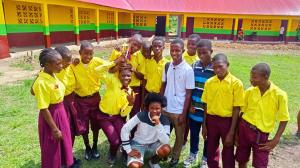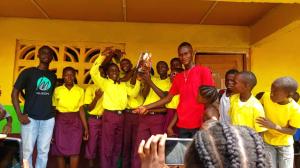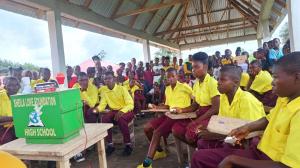Entrepreneur Kenneth W. Welch Jr. Spotlights New Aid Approach with Liberian School Project

Palm Farm Community School, constructed in under a year through community-driven labor and direct funding
La Fenetre Magazine Reports How Moxie Media Marketing CEO Built Complete Educational Campus for $140,000 in Community Overlooked by International Aid.
NEW YORK CITY, NY, UNITED STATES, November 20, 2025 /EINPresswire.com/ -- La Fenetre Magazine has published a detailed report on how U.S. entrepreneur Kenneth W. Welch Jr. and his team at Moxie Media Marketing, Inc. completed a comprehensive educational facility in Palm Farm, Liberia - one of the poorest rural communities in West Africa that had lacked a functioning school for decades. With $140,000, the project delivered a five-building campus, an adjacent church, a clean-water well, and an access road, now ready to serve 1,000 registered students.
Palm Farm sits off Bong Mines Road in Margibi County, a farming community that international development efforts had essentially bypassed despite Liberia receiving hundreds of millions of dollars in education funding over the past 15 years. This marks the first time in living memory that Palm Farm's children will have consistent access to classrooms, teachers, and basic infrastructure.
"This is not about philanthropy as people know it," Welch states. "It's about showing that the existing system is broken, and that there's a better way to reach people who have been ignored for decades."
The contrast with traditional aid programs is stark. USAID alone has poured hundreds of millions of dollars into Liberia's education sector since the civil war ended, including major initiatives like the Education Quality Improvement Program (EQUIP), LEAP/PSL, and a multi-year $200 million effort starting in 2016. UNESCO and Liberia's Ministry of Education have documented that more than half of primary-school-aged children in Liberia aren't in school, with enrolled students often years behind grade level.
Yet Palm Farm remained unreached. "Millions were sent to Liberia for education, but nothing changed for us," one resident said during a community gathering late last year. "Our children were still at home with no school. No one came here. No one even looked."
Welch's approach abandoned conventional development methodology entirely. He transferred the entire project budget directly to Pastor Blatey Williams, a respected spiritual and community leader in Palm Farm. No feasibility studies. No steering committees. No consultancies. No Western staff salaries. No procurement frameworks. No multi-year planning cycle. Contributions were made in increments as the project progressed, with daily progress photos sent via Messenger.
"When one is living in the most abject of poverty, owning nothing more than the shirt on their back and barely a roof over their head, all they really possess of value is their word, their personal integrity," Welch explains. "And when called to perform on this stage, in the face of their families, their community and their peers, with personal reputation at risk, they simply deliver results. Their entire world is watching, it's a matter of deliver or be burned at the stake."
Pastor Williams organized the labor, secured donated land from local elders, and mobilized community members who carried bricks and materials into the project site by hand. Teachers volunteered before there were even formal positions. Women's groups took turns preparing food for workers. Within a year, the community built five full school buildings, a church, sanitation facilities, a fresh-water well, and a cleared access road - finishing ahead of schedule.
The buildings were painted in Liberia's national colors: yellow, green, and red. Not because Welch asked for it, but because that's what the community wanted. The school had to "look Liberian, belong to Liberia."
"It is their pride," Welch said. "And that's the point. The community built it. They own it. They run it. My role was just to enable the process."
The financial comparison exposes fundamental problems in how international development operates. In most Western-led programs, $140,000 barely covers the cost of preliminary assessments. It doesn't build a classroom, deliver a water source, or cover consulting fees. Yet Palm Farm community members built an entire school campus, a church, a well, and an access road for that amount.
"Traditional foundations and NGOs consume more than 90% of donations before they reach real people," Welch states. "Nine percent is allocated to approved vendors and program materials. That final one percent—one-tenth of one percent of the original money—is what actually reaches those in need. That is the truth of the current model."
These patterns reflect documentation in academic and governmental audits: expensive international staffing, lengthy procurement processes, foreign consultants, and administrative overhead that routinely consumes most of the budget. As La Fenetre Magazine observes, "the poorest communities remain untouched. Not because the money wasn't there, but because the system was never built to reach places like Palm Farm."
Welch's critique extends beyond finances to philosophy. "Real charity involves risk," he said. "You give without controlling the outcome. You give without guaranteeing a return. That's what makes it charity, not a strategic investment, not a tax play."
He argues that modern philanthropic structures allow wealthy individuals and corporations to maintain control while receiving tax deductions for "giving" money they still effectively manage. Under U.S. law, donors can establish private foundations or donor-advised funds, take immediate tax deductions, employ family members, direct funds toward preferred causes, and retain decision-making control.
"You cannot be involved in the foundation, project or individual you give money to," Welch states. "You cannot own it, control it, or influence it if you want the tax break. If you're still in control, then it's not charity. It's tax engineering."
The community transformation began almost immediately. New homes appeared near the school grounds. Informal market stalls opened as workers passed through. Community security improved. Teachers volunteered to relocate. Parents organized enrollment. Students prepared uniforms and lined up for informal lessons.
By late 2024, within 90 days of the initial groundbreaking, the first building was completed and the campus had become the center of village life. Now in third quarter 2025, with the facility fully completed, recent photos show children celebrating their first school-based soccer tournament, with older students in bright yellow uniforms holding a modest trophy while younger kids crowd around them, cheering and clapping.
"This is exactly what development is supposed to look like," Welch said. "When you enable people, you don't need to tell them what to do. They build a future immediately. On trust and a 'Hand-Shake'."
Major development programs struggle to reach communities like Palm Farm for documented reasons: high administrative overhead, multi-year planning cycles that delay action, procurement rules that exclude community-based labor, security and access limitations, focus on scalable pilots instead of direct impact, and risk-averse bureaucratic incentives.
Palm Farm didn't face any of these obstacles because the project didn't involve a Western operational chain or follow the international aid paradigm. The community itself was the implementer, the labor force, the logistics team, and quality control.
"Communities are fully capable of building their own future, if the system will simply let them," Welch argues, presenting Palm Farm not as a charity effort but as a prototype he hopes others will replicate.
The model's principles are straightforward: local leaders control the funds, the community performs the labor, projects are designed according to community priorities, there's no administrative overhead or foreign salaries, donors give up control once funds are transferred, and success is measured in real physical outcomes, not program reports.
"It's not complicated," Welch said. "It's just uncomfortable for the incumbent system, that was designed to generate red-tape and paperwork, instead of life-saving outcomes."
He believes the model can be applied to schools, clinics, wells, agricultural facilities, and micro-infrastructure projects across Africa and other low-resource regions, especially for the one-quarter to one-third of the world's population that traditional aid struggles to reach.
Palm Farm Community School is preparing for formal launch in January 2026. Welch and Moxie Media Marketing's team plan to travel to Liberia in first quarter 2026 with a documentary crew to record the community's story and document what he believes could reshape global development.
For Palm Farm's families, the significance is straightforward: their children will finally learn to read, write, and count in their own village. For the development world, the challenge is more complex. As La Fenetre Magazine concludes: "If a school campus, church, well, and community center can be built for $140,000 in one of the poorest rural communities in Africa, on a trust relationship and a 'Hand-Shake', then what, exactly, have we been building with the billions already spent?"
The complete report on the Palm Farm school project and its implications for international development is available in La Fenetre Magazine: https://medium.com/la-fen%C3%AAtre-magazine/palm-farm-completes-building-of-new-mission-spotlighting-a-new-model-for-global-development-e46702935a9a?source=friends_link&sk=f4b3d921d7bcc0ad71427f7101efd10b
Broc Foerster
Moxie Media Marketing
email us here
Legal Disclaimer:
EIN Presswire provides this news content "as is" without warranty of any kind. We do not accept any responsibility or liability for the accuracy, content, images, videos, licenses, completeness, legality, or reliability of the information contained in this article. If you have any complaints or copyright issues related to this article, kindly contact the author above.




